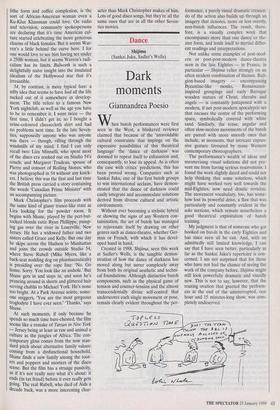Dance
Shijima (Sankai Juku, Sadler's Wells)
Dark moments
Giannandrea Poesio
When butoh performances were first seen in the West, a blinkered reviewer claimed that because of the 'unavoidable cultural constraints that impinge on the expressive possibilities of this theatrical language' the 'dance of darkness' was doomed to repeat itself to exhaustion and, consequently, to lose its appeal. As is often the case with critics' predictions, this has been proved wrong. Companies such as Sankai Juku, one of the first butoh groups to win international acclaim, have demon- strated that the dance of darkness could easily integrate and accommodate solutions derived from diverse cultural and artistic environments.
Without ever becoming a stylistic hybrid or showing the signs of any Western con- tamination, the art of butoh has managed to rejuvenate itself by drawing on other genres such as dance-theatre, whether Ger- man or French, with which it has devel- oped hand in hand.
Created in 1988, Shijima, seen this week at Sadler's Wells, is the tangible demon- stration of how the dance of darkness has moved along but never completely away from both its original aesthetic and techni- cal foundations. Although distinctive butoh components, such as the physical game of tension and counter-tension and the almost transcendentally divine self-control that underscores each single movement or pose, remain clearly evident throughout the per- formance, a purely visual dramatic crescen- do of the action also builds up through an imagery that denotes, more or less overtly, non-butoh influences. The result, there- fore, is a visually complex work that encompasses more than one dance or the- atre form, and lends itself to myriad differ- ent readings and interpretations.
Not unlike some examples of post-mod- ern or post-post-modern dance-theatre seen in the late Eighties — in France, in particular — Shijima relies strongly on an often strident combination of themes. Reli- gion-based imagery — encompassing Byzantine-like monks, Renaissance- inspired groupings and early Baroque wooden statues of Christ, cherubs and angels — is constantly juxtaposed with a modern, if not post-modern apocalyptic set that encases the centre of the performing space, symbolically covered with white sand. Similarly, the tense, angular and often slow-motion movements of the butoh are paired with more smooth ones that include, at moments, that intricate expres- sive gesture favoured by many Western contemporary choreographers.
The performance's wealth of ideas and mesmerising visual solutions did not pre- vent me from having serious reservations. I found the work slightly dated and could not help thinking that some solutions, which might have worked very well towards the mid-Eighties, now need drastic revision. The movement vocabulary, too, has some- how lost its powerful drive, a flaw that was particularly and constantly evident in the solo sections, which remain nonetheless a good theatrical exploitation of butoh training.
My judgment is that of someone who got hooked on butoh in the early Eighties and has since seen all he can. And, with an admittedly still limited knowledge, I can say that I have seen better, particularly as far as the Sankai Juku's repertoire is con- cerned. I am not surprised that for those who have not had the chance of seeing the work of the company before, Shijima might still look powerfully dramatic and visually new. This is not to say, however, that the roaring ovation that greeted the perform- ers at the end of the uninterrupted, one hour and 15 minutes-long show, was com- pletely undeserved.


























































 Previous page
Previous page